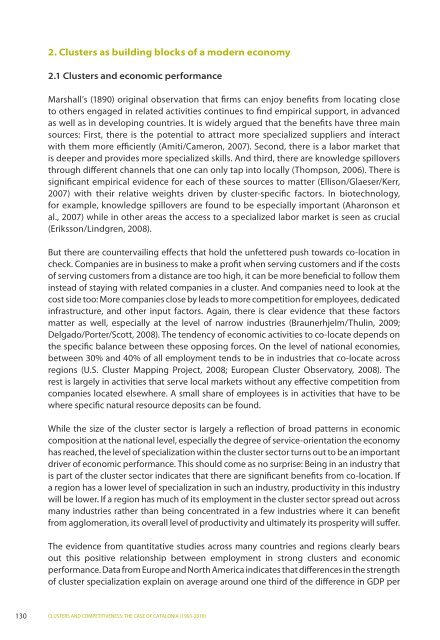Clusters and competitiveness - PRO INNO Europe
Clusters and competitiveness - PRO INNO Europe
Clusters and competitiveness - PRO INNO Europe
You also want an ePaper? Increase the reach of your titles
YUMPU automatically turns print PDFs into web optimized ePapers that Google loves.
2. <strong>Clusters</strong> as building blocks of a modern economy<br />
2.1 <strong>Clusters</strong> <strong>and</strong> economic performance<br />
Marshall’s (1890) originalobservationthatfirmscanenjoybenefitsfromlocatingclose<br />
toothers engaged in related activities continues to find empirical support, in advanced<br />
as wellasindevelopingcountries.Itiswidelyarguedthatthebenefitshavethreemain<br />
sources:First,thereisthepotentialtoattractmorespecializedsuppliers<strong>and</strong>interact<br />
withthem more efficiently (Amiti/Cameron, 2007). Second, there is a labor market that<br />
is deeper <strong>and</strong> provides more specialized skills. And third, there are knowledge spillovers<br />
throughdifferentchannelsthatonecanonlytapintolocally(Thompson,2006).Thereis<br />
significant empirical evidence for each of these sources to matter (Ellison/Glaeser/Kerr,<br />
2007) withtheirrelativeweightsdrivenbycluster-specificfactors.Inbiotechnology,<br />
for example, knowledge spillovers are found to be especially important (Aharonson et<br />
al., 2007)whileinotherareastheaccesstoaspecializedlabormarketisseenascrucial<br />
(Eriksson/Lindgren, 2008).<br />
But therearecountervailingeffectsthatholdtheunfetteredpushtowardsco-locationin<br />
check. Companies are in business to make a profit when serving customers <strong>and</strong> if the costs<br />
ofservingcustomersfromadistancearetoohigh,itcanbemorebeneficialtofollowthem<br />
insteadofstayingwithrelatedcompaniesinacluster.Andcompaniesneedtolookatthe<br />
costsidetoo:Morecompaniesclosebyleadstomorecompetitionforemployees,dedicated<br />
infrastructure, <strong>and</strong> other input factors. Again, there is clear evidence that these factors<br />
matter aswell,especiallyatthelevelofnarrowindustries(Braunerhjelm/Thulin,2009;<br />
Delgado/Porter/Scott, 2008). The tendency of economic activities to co-locate depends on<br />
the specific balance between these opposing forces. On the level of national economies,<br />
between 30%<strong>and</strong>40%ofallemploymenttendstobeinindustriesthatco-locateacross<br />
regions(U.S.ClusterMappingProject,2008;<strong>Europe</strong>anClusterObservatory,2008).The<br />
restislargelyinactivitiesthatservelocalmarketswithoutanyeffectivecompetitionfrom<br />
companieslocatedelsewhere.Asmallshareofemployeesisinactivitiesthathavetobe<br />
where specific natural resource deposits can be found.<br />
While thesizeoftheclustersectorislargelyareflectionofbroadpatternsineconomic<br />
composition at the national level, especially the degree of service-orientation the economy<br />
hasreached,thelevelofspecializationwithintheclustersectorturnsouttobeanimportant<br />
driver of economic performance. This should come as no surprise: Being in an industry that<br />
ispartoftheclustersectorindicatesthattherearesignificantbenefitsfromco-location.If<br />
aregionhasalowerlevelofspecializationinsuchanindustry,productivityinthisindustry<br />
willbelower. If a region has much of its employment in the cluster sector spread out across<br />
many industries rather than being concentrated in a few industries where it can benefit<br />
from agglomeration, its overall level of productivity <strong>and</strong> ultimately its prosperity will suffer.<br />
The evidence from quantitative studies across many countries <strong>and</strong> regions clearly bears<br />
out this positive relationship between employment in strong clusters <strong>and</strong> economic<br />
performance. Data from <strong>Europe</strong> <strong>and</strong> North America indicates that differences in the strength<br />
of clusterspecializationexplainonaveragearoundonethirdofthedifferenceinGDPper<br />
130 CLUSTERS AND COMPETITIVENESS: THE CASE OF CATALONIA (1993-2010)
















